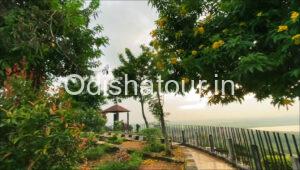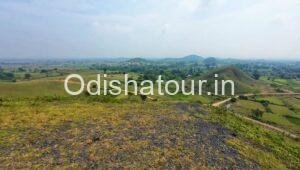Ulapgarh Hill Fort is a hillock located about 6 km distance from Belpahar and 28 km from Jharsuguda. It is said that revolutionaries fighting in India’s freedom struggle took refuge in this hillock. The spaces carved out of the rock face to hold torches can still be seen to this day. The journey uphill requires a strong disposition, as the sun and dry heat can take a toll on one’s physical endurance. However, once the summit is reached, the view is truly breathtaking. The combination of lush greenery and profound silence is deeply restorative. Visitors are advised to remember the path they took, as descending through a different route could result in getting lost. The hill fort is also a popular picnic spot. At the foot of Maheswar Pahad lies a small village called Ulap. About one kilometre from the village are the ruins of Ulapgarh.
At this location, Maheswar Pahad rises to about 1,000 feet. On top of the hill is a vast, flat stone surface where the fort of Ulapgarh once stood. This rectangular stone platform measures approximately 400 meters in length and 250 meters in width. To the east of the fort lie the densely forested Baramunda Hills, stretching for about 7 km. To the west, Belpahar Railway Station is situated roughly 5 km away. Dense forests extend northward up to Hemgir, and southward to Bad Job Village. A 12-foot (3.66 m) wide and 500-foot (150 m) long moat had been constructed, running from east to west. Within the fort, there was a Shivalingam and a designated place of worship. A well had been dug into the stone floor, providing drinking water to the fort’s inhabitants throughout the year.
History of Ullapgarh Fort
On the stone floor, there are many square holes and 70 round holes. The diameters of the holes vary from 1 to 3 inches. Wooden poles used to be put in these holes to support superstructures for the living room, storeroom, arsenals, kitchen, sleeping room, etc. About 1000 people could take shelter at Ulapgarh at a time. On the western side of Ulapgarh and downhill, there is Ushakothi cave. On the walls and floors of this cave, there are also many circular and square holes. Probably the defence personnel of the fort used to suspend their clothes and other belongings from wooden poles fitted to these holes. The soldiers of the dense forest of Maheswar Hill could easily overpower and defeat the enemies before they could climb up the hill and attack the fort. It is believed that Ulapgarh was being used as a residential fort by some kings of the “Naja” Dynasty. This is being researched by both Indian and foreign researchers and historians. Ulapgarh Hilltop is a tourist attraction in Jharsuguda. Source




Other Services
Destination Attractions, Destination Facilities, Transportation, Accessibility, How to Reach





























